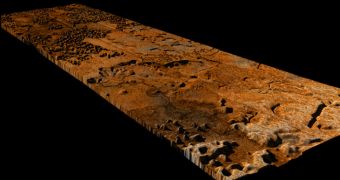Since the NASA/ESA Cassini spacecraft began orbiting Saturn, experts have been puzzled by the radar images the orbiter kept sending back of the bizarre moon Titan. The surface of the rock appeared to be covered in weird, liquid hydrocarbon lakes, but also in honeycomb-like patterns, and flat valleys that geologists couldn't make sense of. These features had “squiggly edges,” which were fairly obvious in the radar datasets.
At last, after employing the help of a “volunteer researcher,” scientists managing the Cassini mission were able to find an analogy for these terrains on our own planet. This will make it easier for geologists and planetary scientists to figure out what processes may have contributed to their formation, experts at the NASA Jet Propulsion Laboratory (JPL) say.
The Cassini experts say that the features on Titan resemble a form of spectacular terrestrial landscape called karst topography. The researchers presented their new conclusions in The Woodlands, Texas, at the Lunar and Planetary Science Conference. Basically, geologists explain, karst terrain forms when water takes to dissolving layers of bedrock, creating spectacular outcroppings and sinkholes, all made of stone. At the meeting, the scientists presented various examples of such terrain here on Earth, including those in White Canyon, Utah, in the Darai Hills of Papua New Guinea, and in the Guangxi Province of China.
Alongside these images, they showcased models of the Sikun Labyrinthus on Titan. This is an area of interconnected valleys and ridges, whose depiction has been produced by inferring its 3D layout. On top of this data, experts stitched readings collected by the Cassini radar instruments, thus providing a never-before-seen view of the region (video available here). “Even though Titan is an alien world with much lower temperatures, we keep learning how many similarities there are to Earth. The karst-like landscape suggests there is a lot happening right now under the surface that we can't see,” says JPL Cassini radar team associate, Karl Mitchell.
A considerable implication that these similarities carry is the exciting possibility of caves existing below Titan's surface in the Sikun Labyrinthus region. “I've been in love with Titan since Cassini beamed down the first images of Titan's Shangri-La sand sea. It's been amazing for the public to see data come down so quickly and get data sets so rich that you can practically imagine riding along with the spacecraft,” says Chapel Hill-based organic chemist Mike Malaska, the amateur that contributed extensively to discovering these analogies.

 14 DAY TRIAL //
14 DAY TRIAL //